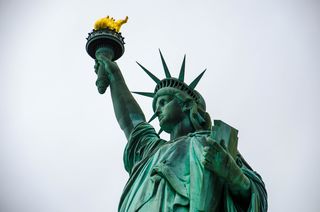Empathy
Empathy for Immigrants
Walking in the shoes of immigrants today connects us to our ancestral past.
Posted September 17, 2018

Who am I? Where did my family come from? Millions of Americans are asking themselves these questions. These are the questions that have motivated them to buy a DNA testing kit. In fact, in recent years more than 12 million people have had their DNA tested through companies that provide the testing directly–dab the inside of your cheek with a swab, send it in and then wait to find out where your ancestors came from and who you might be related to now. There are genealogy software programs and phone apps to help you do this work. We even have a popular television series, “Finding Your Roots,” that traces the ancestry and family history of celebrities.
The truth is, other than Native Americans, we are all immigrants to this country, some forced through capture and slavery, others to escape famine, danger, and poverty. For example, in the 50 years following the Potato Blight of 1845 in Ireland, almost half of the population left, most of whom came to the United States. One of the most moving accounts of this journey is in the lyrics of a song about a young man who leaves his family in Kilkelly, Ireland to make his way in America. It is based on the real letters written between a father and a son. I found listening to the song touched me deeply, in a very empathic way. I urge you to take a few minutes and listen.
Today, almost 12 percent of Americans claim their ancestry is Irish and another 17 percent of Americans claim ancestry from Germany.1 Many Americans do not know their ancestry, but know it was from another part of the world and so they buy the DNA testing kits.
Simply put, we are a nation of immigrants.
To be an immigrant means leaving your place of origin, by choice or forcibly, to live in a new place, often with little opportunity to return. Even for indigenous people in this country, most were forcibly removed from their ancestral lands with no option to return. What does this shared immigrant history mean?
If you are the descendant of an immigrant, and you have empathy, there is only one choice today. That choice is to welcome the stranger to our land. We can walk in the shoes of today’s immigrants with the knowledge that those were the steps taken by our own ancestors. For most, it was not easy. Some were enslaved. Decade after decade, they were not welcomed with open arms. Immigrants who were refused entry found a way and came anyway, from Ireland, Scotland, Italy, Germany, Poland, Russia, China, and more. The list is long.
If I use my social empathy skills to understand what that journey and experience was like, I will be able to imagine my great grandparents and my grandfathers making that dangerous journey, coming to a land where they did not know the language, having no money, and leaving behind relatives they would never see again. I would see that same story for immigrants today. And because my ancestors were allowed to stay, now it is a chance for me to extend that opportunity to others.
I can learn a lot from a DNA testing kit. But I can also learn a lot from social empathy. If I apply the building blocks of social empathy, the art of understanding the lived experiences of those who are from groups different than my own, I would learn about the circumstances of my own heritage and compare that to those who are seeking to come to this country today. I may not trace my family roots to Mexico or Haiti or Syria or Somalia, but I share their stories. Like so many immigrants, my ancestors came to this country for safety and a chance to make a living. They left because conditions were so bad that is was better to embark on a long and dangerous journey to an unknown place rather than stay and risk starvation and persecution. I would find the words on the pedestal of the Statue of Liberty speak to me. Those words describe a “mighty woman with a torch” holding a flame that “glows world-wide welcome” to those from other lands "yearning to breathe free."2
If you engage in social empathy to understand immigration today, you will see the story of your ancestors. Would you have wanted your ancestors arrested, shackled at the border, put in prison, separated from their children, and children as young as toddlers not knowing where their parents are? I think not. How can we, the descendants of immigrants, not see our family stories retold, not see our own history in the immigrants of today? Learn about your ancestry and use your social empathy to walk in the shoes of immigrants today. Welcoming today’s immigrants will feel like welcoming your ancestors home.
References
1. For a complete history of immigration to this country that identifies the different paths taken by different groups, visit the Library of Congress’ full history of immigration in this country, including the forced relocation of Native Americans and the forced immigration and slavery of black Africans :
2. From the poem "The New Colossus" by Emma Lazarus that was written in 1883 to raise money to build the pedestal for the Statue of Liberty. In 1903 the entire poem was inscribed on the base of the statue.


